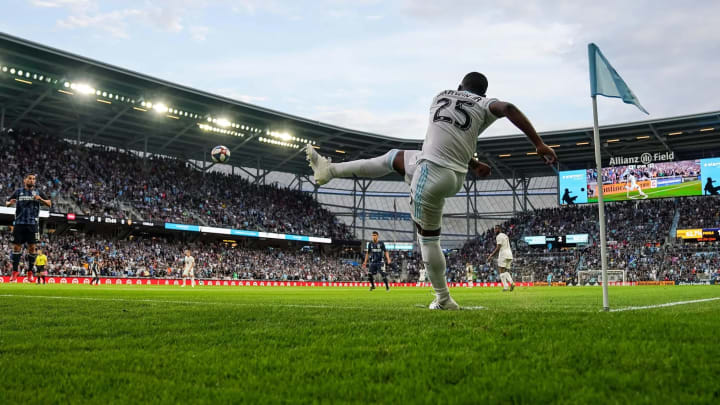
Goals Drive Progress
October 10, 2017.
If you’re a fan of the United States Men’s National Team, you know what happened on that day. Bad, bad, bad. Just not good. Less than ideal. A trip to the World Cup — the World Cup!! — on the line, and we couldn’t manage a draw against Trinidad and Tobago.
A lot has been said and written about that night, and what it meant for soccer in our country. I found myself very emotional after that match — just like so many fans. Not because I was upset — or I should say, not just because I was upset. But because I was … heartbroken. This sport means so much to me, to our country. Look at our women’s team. How much fun did you have watching them this summer? It was incredible. They were incredible.
The mens’ team has the potential to deliver months like that, years like that. I believe that. I really do. But the first question I had after that defeat in Trinidad — and I asked it on TV — was this:
Is our national team capable of change?
That’s the question, I think, that we — those who care deeply about the sport in our country — need to be asking one another.
And, further, are we willing to change?
Here we are, getting close to the two-year anniversary of that loss, ramping up for another World Cup qualification run. There have been cosmetic changes — new GM, new coach — but what about the roots of our sport, from which our national team springs? Have they been strengthened?
There are a few things I want to mention in this article, because they are things that we need to keep working on and talking about.
Consider this a letter to our national team, to MLS, and to the fans, from a kid named Taylor who grew up St. Louis. A kid who played in the NCAA, who played in MLS and who played for his country. Who knows the system. Who has not just seen, but also lived its flaws, its strengths. Who wants to be part of the turning tide, and who wants to see the men’s national team win the World Cup.
The Player Needs to Be Himself
The American obsession with coaches really leaves me speechless sometimes. Look, I understand how important they are in some sports. I went to Maryland on a baseball scholarship. I see the way travel team coaches are revered. Basketball, American football and baseball at the college and youth level are all dominated by coaches. They are more often than not the stars.
Soccer is about the player. It’s not about X’s and O’s all the time. It’s about the player and the ball. That’s how you get creative athletes. But at such a young age, we expose our youth players to these rigid systems, and leave them in the hands of coaches who think they are bigger than the sport.
That’s how we lose our creativity. You can’t coach a player to be unique, you just have to let them be. One of the beautiful things about soccer in our country is that a player from California can have a very different style than one from Maine. We should embrace that, especially at younger ages.
And I do believe we have a lot of creative players in this country — but winning a World Cup is about more than having a lot of them. It’s about having an army.
I remember after my U17 team went to the World Cup in Egypt, U.S. Soccer introduced the residency program in Bradenton, Florida. It helped produce such players as Landon Donovan and DaMarcus Beasley, but also created a new issue. It was pulling all these 15-,16-,17-year-old boys from different states to one place and turning them all into the same player, with the same personality — making them into robots. Thankfully, that program doesn’t exist anymore.
The residency programs that MLS academies have created have taken that idea, refined it and bettered it, and are starting to excel at diversifying their player pool. That’s where more of our clubs’ resources should be going, and that’s how we can begin to create better, more unique players for our clubs and our national teams.
Thirty-plus academies all around the country creating different players — that’s what we need. And we’re getting there.
The NCAA
From the ages of 17 to 21, the U.S. is playing checkers and the rest of the world is playing chess — simple as that.
Our program should be geared toward developing players to win a World Cup, right? That’s why we’re here, that’s why we’re talking about this. But, as of now, we’re focused on trying to secure college scholarships for players. And we’re trying to get them to be NCAA student-athletes. Which, in theory, is great. I’m all for creating well-educated individuals who can be more than soccer players.
But the NCAA treats soccer like we’re living in 1960, not 2019. These teams have a three- or four-month season, They play a couple of games a week and coaches are not allowed to actually coach and teach the players because they are handcuffed by archaic rules that limit how much time they can actually spend with their athletes. It’s unfair to expect those players to become world-class professionals, let alone World Cup winners. It’s just not going to happen.
As far as soccer goes, right now, the NCAA is not in the business of creating world class players, simple as that.
Inclusivity
There are many, many different points of view in this country on how to fix our soccer program. Honestly, it’s very difficult to pinpoint what’s right and what’s wrong because when you fail to qualify for a World Cup how can you say at that point that one approach is right or that another is wrong?
Many generations have failed. I don’t know who has the right point of view. But I know the answer isn’t fewer ideas. We need more ideas, more dreamers.
Look at Norway, for example, a country with a population the size of Minnesota’s, which won the most medals of any nation at the last Winter Olympics. Norway has also produced one of the world’s best beach volleyball players and one of the world’s best women’s soccer players— stars in two Summer Olympic sports!
Norway has succeeded in its various sports programs by making them affordable to play in at any level. I can’t stress this enough: Soccer has to be cheaper to play in our country if we want to have success. There’s a great, great HBO Real Sports feature about the Norwegian athletic system, and I can’t recommend it enough.
That’s what inclusivity means to me when we’re talking about sports. Nobody, regardless of economic background or physical ability, is excluded from playing.
The problem with soccer in my generation was exclusivity. If you weren’t elite at 11 years old, well, too bad, you were essentially cut off from the chance of ever being a great player. The drop off in resources from one level of the sport to the next is too steep.
That’s not the way it is elsewhere around the world, even though Americans may not be aware of that fact. Look at France and its World Cup-winning team. Some of the guys on that squad were playing in the third or fourth division just a few years ago.
There needs to be a way for U.S. players to find their way back to national team program at a later age. This may seem vague, but it relates back to our issues from the ages 17–21. If an outstanding youth player is not quite good enough to make an MLS academy, then his only other option is to play high school soccer — where he’ll probably never be heard from again.
I think any such process would be very difficult to implement, but I don’t think it would be impossible. Anyone in our country who says it’s impossible either doesn’t want to roll their sleeves up and do the work required to actually pull it off, or doesn’t really aspire to winning a World Cup.
MLS and Expansion
Major League Soccer is obviously a large piece of this puzzle, and has been since its inception. Whether it’s players like DeAndre Yedlin, Tyler Adams or Alphonso Davies, who developed in the league and parlayed that success into a contract with a top European club, or someone like Weston McKennie, whose time at an MLS academy allowed him to reach a high level at only 18 years old. You also have the first homegrown player to be a designated player like Gyasi Zardes. Breakout stars are essential to the success of the league. MLS is on the precipice of being the breeding ground for young talent. But the core of all of this, has to be the American player and finding a way to get him to the highest level. That was the foundational belief in 1996, when MLS started, and it is even more important now because MLS will play a crucial role in the USMNT’s quest to win a World Cup. And that means either developing current players or helping players move on to different leagues.
One of the products of MLS and it’s ongoing growth will be an increase in the size of the player pool. This will require patience and, well, all of the things I’ve talked about today — but it’s one of the most important elements. As the league expands and finds success in places such as Atlanta, L.A., Minnesota and Cincinnati, my hope is that a young kid discovers the game, and begins a journey that includes their wearing the U.S. kit one day.
The success of the national team reverberates back into the domestic league and teams, we know that. Look at our women’s team and the bump their leagues are receiving because of their successes on the biggest stage.
So, for our owners, our commissioners — the people who can throw their weight around and make real change — it’s critical that they keep the national team in mind. It’s all connected. For a while we forgot that, I think.
We can’t ignore those ties anymore. The World Cup is coming here soon, and there will be nowhere to hide, nobody to blame, if we can’t show what we’re capable of.
The goal in our country, from top to bottom, has to be for the United States Men’s team to win a World Cup. And if it’s not, we’ve got to find a way to fix that. We have to be united in our idea.
The issues I’ve talked about here are paramount in any discussion involving our national team, I believe. And those talks should continue, and that’s where the hard work starts.
That’s why I’m all-in with Audi, a company that’s trying to help address some issues that MLS academies are dealing with, such as education, housing and transportation. Substantial and tangible changes in those areas can come first, and will have an impact on our program down the road.
If MLS academies — and all other U.S. soccer academies — come together and develop players for the sake of the player, not the club, that’s how we’ll find success. And in 2026, or 2030, if we’re talking about the men’s team in the same light as the women’s — we’ll know it was because of the changes made by our clubs, right here at home in our MLS academies.

